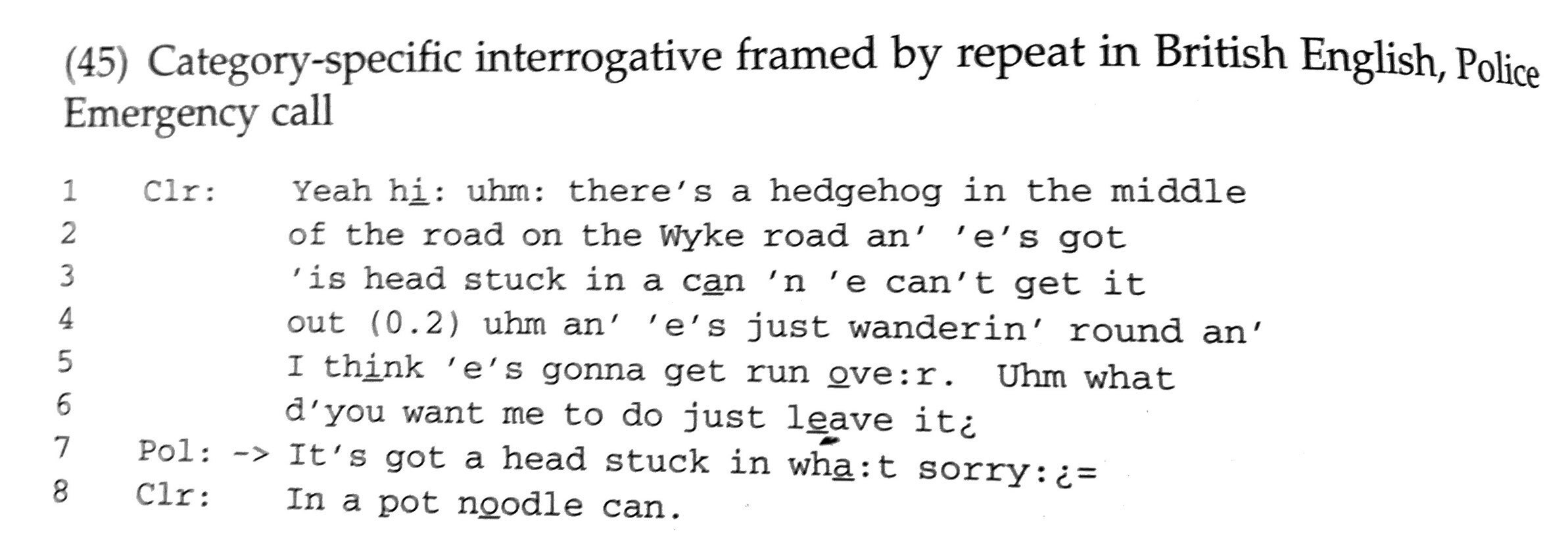Seminar 3 Repair
Aims for Topic 3: Repair
Seminar: How do we fix errors or make revisions to our own talk? How do others point out a problem? Are there any problems in the listener fixing the problem?
Workshop: Can you find examples of repair in conversation? What are the implications of doing repair ‘properly’?
A: Oh Sibbie's sistuh had a baby boy.
B: Who?
A: Sibbie's sister.
B: Oh really
Enfield, N.J. (2017) How we talk: The inner workings of conversation. New York: Basic Books. (p.146)
We see at every turn, whether the projected action was the right one.
Schegloff, E.A (1987) Recycled turn beginnings: A precise repair mechanism in conversation’s turn-taking organisation. In G. Button & J.R.E. Lee (Eds.) Talk and social organisation (pp. 70-85). Clevedon, UK: Multilingual Matters.
The following extracts are from:
Kitzinger, C. (2012) Repair. In J. Sidnell, J. & T. Stivers, T. (eds.) The Handbook of Conversation Analysis (pp. 229-256). Chichester: Wiley-Blackwell.
Self repair
Activity
In your breakout groups, identify what is being repaired in each pair of examples. Ask yourselves:
What is the troublesource or problem that this repair resolves?
What are the differences between each pair of examples.
(The extracts below are taken from this topic's essential reading: Kitzinger, C. (2012) Repair. In J. Sidnell, J. & T. Stivers, T. (eds.) The Handbook of Conversation Analysis (pp. 229-256). Chicester: Wiley-Blackwell.)
Group discussion: What are the differences between the three pairs of examples?
Other-initiated repair
Open class repair initiators (Drew, 1997): ‘sorry?’ ‘pardon?’ ‘huh?’ ‘what?’
Activity
In your breakout groups, for each example of other-initiated repair below, answer the following question: What is the troublesource? (ie what is the problem the person initiating the repair is seeking to resolve?
Then discuss: What is the difference between these examples of other-initiated repair?
All examples are taken from Kendrick, K.H. (2015). "Other-initiated repair in English" (Links to an external site.), Open Linguistics, 1(1) 164–190.





Group discussion: Preference for self-repair (ie other-initiated other repair the last resort!)
In Extract 6, the go-ahead is not produced by Paul. He does produce a contingent response to Harry's declaration. In line 69 we might expect something like "oh yeah, what are they?", for Paul to acknowledge Harry's assessment so far, and to query what these two reasons are. The very unusual (because we know the rules of talk-in-interaction make turns predictable) feature of this extract is that Harry does not pursue the repair. Typically, troubles need to be resolved in order for conversation to proceed smoothly. Here is a bump in the conversational road.
This finding is explained in more detail in the discussion of our paper which you can read here.
Summary
Here is a useful summary/definition of repair provided by Bolden (p. 143):
Bolden, G.B. (2018). "Speaking ‘out of turn': Epistemics in action in other-initiated repair", Discourse Studies, 20(1), 142–162.
In this topic we learned about repair and how speakers fix troublesources in interaction. We now know that:
there is a preference for repair to be done as soon as possible (ie within turn or self-repair, or in the very next turn for other-initiated repair)
There is a preference or self-repair, then other initiated self-repair, that speakers have the opportunity to revise], clarify or correct the troublesource.
overall this mechanism of managing meaning in interaction enables progressivity - ie we can keep going assuming that all is well unless flagged (no news is good news!)
















